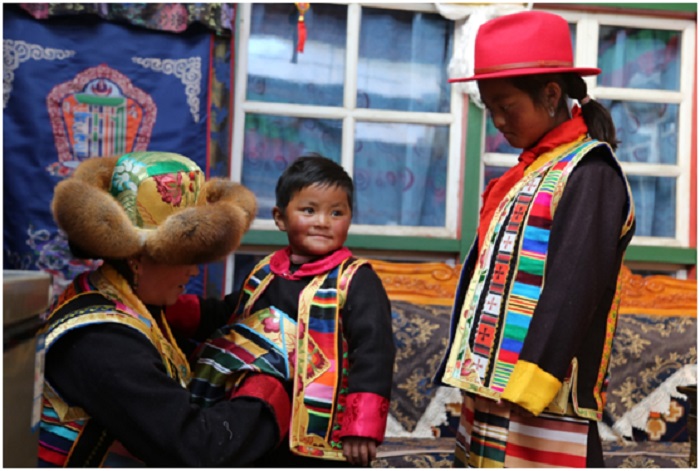



Festive atmosphere has been seen everywhere recently in southwest China’s Tibet autonomous region, as the 2022 Tibetan New Year approached. The Tibetan people, dressed in brand-new clothes, have been caught up in holiday purchases and visiting their friends and relatives to send their New Year wishes.
During the Tibetan New Year, commodities have been on sufficient supply with stable price on the markets of Lhasa, capital of Tibet autonomous region. On high demand, they were selling briskly.
At the Pargor Supermarket located in Pargor, a commercial center of Lhasa, plenty of consumers were seen making New Year purchases. All kinds of festive goods were placed on the shelves, such as traditional Tibetan costumes, Tibetan butter sculptures and Chemars, a fine box containing roasted highland barley flour praying for good harvest.
Sufficient commodity supply and stable operation of the market have been ensured to make the Tibetan New Year happy and peaceful. For instance, a special New Year purchase section of a supermarket in Lhasa has stored over 500 tonnes of staple food before the Tibetan New Year, and it has also increased the supply of roasted highland barley flour and yak butter. According to an executive of a farm produce fair in Lhasa, over 200 tonnes of vegetables and fruits have been sold in the city on a daily basis, and stable prices has been ensured for vegetables, fruits, meat and aquatic products.
To celebrate the Tibetan New Year, diverse cultural activities have been held across the autonomous region. On March 2, the 2022 Tibetan New Year gala was aired. Numerous families watched the show while sipping Tibetan butter tea and enjoying pastries. Apart from being played on TV, the show was also livestreamed on multiple internet platforms.
In Baingoin county, Nagqu city of Tibet, over 100 people joined Tibetan New Year art performances for local neighborhoods. At the Senburi relocation site in Gonggar county, Lhoka, local cadres have presented a splendid New Year show, which included 13 performances such as solo singing and dancing.
Zheng Zhiping is a senior citizen living in Beimen neighborhood, Jiantang township in the majority Tibetan city of Shangri-La, southwest China’s Yunnan province. The 70-year-old man had taught at local primary schools in the city for 30 years since he graduated from a normal university in 1978.
“School facilities were poor in the old days. In Dongwang township, over half of the villages were not connected to hardened road. It took a day to get to the township government from the farthest village,” Zheng recalled.
Now, Dongwang township is connected to a newly built highway, which has significantly shortened the travel time for local residents.
Speaking of the rapid development today, Zheng was quite exciting. “We are just developing fast now. Downtown Shangri-La used to cover less than one kilometer, but today it’s been expanded more than 20 times,” he said.
“In the past, schooling of the children was a huge economic burden for local families, but now they have subsidies. We had only 9-year compulsory education before, but now rural children enjoy 15 years of free education,” Zheng told People’s Daily.
According to him, a cafeteria was opened in his neighborhood last year, where each meal is priced at only 10 yuan ($1.58) and senior citizens can have it at six yuan. The food there was diverse, he said.
A high-speed railway is scheduled to become operational in Shangri-La this year, which will further facilitate the transportation of local residents.
More and more policies are being rolled out today to benefit the people, and the days are just getting better, Zheng said.


The Executive and members of the.


The Acting Director, FCT Directorate of.


President Bola Ahmed Tinubu has been.



Barely a month after resignation of.


An Abuja based Legal Practitioner, Osuagwu.



Convener of Equitable Remedy, Mrs. Magaret.


Contractors handling the contract for city.


Nigerian government may have concluded plans.


The Diplomatic Correspondents Association of Nigeria.


A rights group, “Follow Me Talk.
Leave a Comment